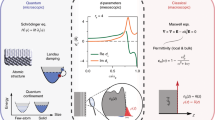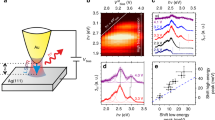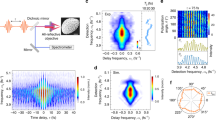Abstract
To move nanophotonic devices such as lasers and single-photon sources into the practical realm, a challenging list of requirements must be met, including directional emission1,2,3,4,5, room-temperature and broadband operation6,7,8,9, high radiative quantum efficiency1,4 and a large spontaneous emission rate7. To achieve these features simultaneously, a platform is needed for which the various decay channels of embedded emitters can be fully understood and controlled. Here, we show that all these device requirements can be satisfied by a film-coupled metal nanocube system with emitters embedded in the dielectric gap region. Fluorescence lifetime measurements on ensembles of emitters reveal spontaneous emission rate enhancements exceeding 1,000 while maintaining high quantum efficiency (>0.5) and directional emission (84% collection efficiency). Using angle-resolved fluorescence measurements, we independently determine the orientations of emission dipoles in the nanoscale gap. Incorporating this information with the three-dimensional spatial distribution of dipoles into full-wave simulations predicts time-resolved emission in excellent agreement with experiments.
This is a preview of subscription content, access via your institution
Access options
Subscribe to this journal
Receive 12 print issues and online access
$209.00 per year
only $17.42 per issue
Buy this article
- Purchase on Springer Link
- Instant access to full article PDF
Prices may be subject to local taxes which are calculated during checkout




Similar content being viewed by others
References
Claudon, J. et al. A highly efficient single-photon source based on a quantum dot in a photonic nanowire. Nature Photon. 4, 174–177 (2010).
Kosako, T., Kadoya, Y. & Hofmann, H. Directional control of light by a nano-optical Yagi–Uda antenna. Nature Photon. 4, 312–315 (2010).
Curto, A. G. et al. Multipolar radiation of quantum emitters with nanowire optical antennas. Nature Commun. 4, 1750 (2013).
Hadden, J. P. et al. Strongly enhanced photon collection from diamond defect centers under microfabricated integrated solid immersion lenses. Appl. Phys. Lett. 97, 241901 (2010).
Le Moal, E. et al. An electrically excited nanoscale light source with active angular control of the emitted light. Nano Lett. 13, 4198–4205 (2013).
Noginov, M. A. et al. Demonstration of a spaser-based nanolaser. Nature 460, 1110–1112 (2009).
Russell, K., Liu, T., Cui, S. & Hu, E. Large spontaneous emission enhancement in plasmonic nanocavities. Nature Photon. 6, 459–462 (2012).
Schietinger, S., Barth, M., Aichele, T. & Benson, O. Plasmon-enhanced single photon emission from a nanoassembled metal–diamond hybrid structure at room temperature. Nano Lett. 9, 1694–1698 (2009).
Oulton, R. F. et al. Plasmon lasers at deep subwavelength scale. Nature 461, 629–632 (2009).
Eisaman, M. D., Fan, J., Migdall, A. & Polyakov, S. V. Invited review article: single-photon sources and detectors. Rev. Sci. Instrum. 82, 071101 (2011).
Yablonovitch, E. Inhibited spontaneous emission in solid-state physics and electronics. Phys. Rev. Lett. 58, 2059–2062 (1987).
Purcell, E. Spontaneous emission probabilities at radio frequencies. Phys. Rev. 69, 681 (1946).
Gérard, J. et al. Enhanced spontaneous emission by quantum boxes in a monolithic optical microcavity. Phys. Rev. Lett. 81, 1110–1113 (1998).
Englund, D. et al. Controlling the spontaneous emission rate of single quantum dots in a two-dimensional photonic crystal. Phys. Rev. Lett. 95, 013904 (2005).
Bleuse, J. et al. Inhibition, enhancement, and control of spontaneous emission in photonic nanowires. Phys. Rev. Lett. 106, 103601 (2011).
Vesseur, E. J. R., de Abajo, F. J. G. & Polman, A. Broadband Purcell enhancement in plasmonic ring cavities. Phys. Rev. B 82, 165419 (2010).
Koenderink, A. F. On the use of Purcell factors for plasmon antennas. Opt. Lett. 35, 4208–4210 (2010).
Anger, P., Bharadwaj, P. & Novotny, L. Enhancement and quenching of single-molecule fluorescence. Phys. Rev. Lett. 96, 113002 (2006).
Filter, R., Słowik, K., Straubel, J., Lederer, F. & Rockstuhl, C. Nanoantennas for ultrabright single photon sources. Opt. Lett. 39, 1246–1249 (2014).
Kinkhabwala, A. et al. Large single-molecule fluorescence enhancements produced by a bowtie nanoantenna. Nature Photon. 3, 654–657 (2009).
Kollmann, H. et al. Toward plasmonics with nanometer precision: nonlinear optics of helium-ion milled gold nanoantennas. Nano Lett. 14, 4778–4784 (2014).
Esteban, R., Teperik, T. V. & Greffet, J. J. Optical patch antennas for single photon emission using surface plasmon resonances. Phys. Rev. Lett. 104, 026802 (2010).
Belacel, C. et al. Controlling spontaneous emission with plasmonic optical patch antennas. Nano Lett. 13, 1516–1521 (2013).
Yi, M. et al. Plasmonic interaction between silver nano-cubes and a silver ground plane studied by surface-enhanced Raman scattering. Plasmonics 6, 515–519 (2011).
Lassiter, J. B. et al. Plasmonic waveguide modes of film-coupled metallic nanocubes. Nano Lett. 13, 5866–5872 (2013).
Ciracì, C. et al. Probing the ultimate limits of plasmonic enhancement. Science 337, 1072–1074 (2012).
Yuan, C. et al. Modification of fluorescence properties in single colloidal quantum dots by coupling to plasmonic gap modes. J. Phys. Chem. C 117, 12762–12768 (2013).
Moreau, A. et al. Controlled-reflectance surfaces with film-coupled colloidal nanoantennas. Nature 492, 86–89 (2012).
Rose, A. et al. Control of radiative processes using tunable plasmonic nanopatch antennas. Nano Lett. 14, 4797–4802 (2014).
Chen, Y., Munechika, K. & Ginger, D. S. Dependence of fluorescence intensity on the spectral overlap between fluorophores and plasmon resonant single silver nanoparticles. Nano Lett. 7, 690–696 (2007).
Cang, H., Liu, Y., Wang, Y., Yin, X. & Zhang, X. Giant suppression of photobleaching for single molecule detection via the Purcell effect. Nano Lett. 13, 5949–5953 (2013).
Lee, K. G. et al. A planar dielectric antenna for directional single-photon emission and near-unity collection efficiency. Nature Photon. 5, 166–169 (2011).
Bakker, R. M. et al. Nanoantenna array-induced fluorescence enhancement and reduced lifetimes. New J. Phys. 10, 125022 (2008).
Zhang, Q., Li, W., Wen, L.-P., Chen, J. & Xia, Y. Facile synthesis of Ag nanocubes of 30 to 70 nm in edge length with CF3COOAg as a precursor. Chem. Eur. J. 16, 10234–10239 (2010).
Acknowledgements
The authors thank A. Rose, R. Hill and A. Baron for discussions. This work was supported by the Lord Foundation of North Carolina and the Air Force Office of Scientific Research (contract no. FA9550-12-1-0491).
Author information
Authors and Affiliations
Contributions
G.M.A. and M.H.M. conceived and designed the experiments. G.M.A. performed the experiments. C.A., G.M.A. and C.C. performed the simulations. G.M.A., C.A. and M.H.M. analysed the data. T.B.H. synthesized the Ag nanocubes. G.M.A., T.B.H., C.F. and J.H. fabricated and characterized the samples. G.M.A., C.A. and M.H.M. wrote the manuscript with input from all authors. M.H.M. and D.R.S. supervised the project.
Corresponding author
Ethics declarations
Competing interests
The authors declare no competing financial interests.
Supplementary information
Supplementary information
Supplementary information (PDF 4222 kb)
Rights and permissions
About this article
Cite this article
Akselrod, G., Argyropoulos, C., Hoang, T. et al. Probing the mechanisms of large Purcell enhancement in plasmonic nanoantennas. Nature Photon 8, 835–840 (2014). https://doi.org/10.1038/nphoton.2014.228
Received:
Accepted:
Published:
Issue Date:
DOI: https://doi.org/10.1038/nphoton.2014.228
This article is cited by
-
Dynamical control of nanoscale light-matter interactions in low-dimensional quantum materials
Light: Science & Applications (2024)
-
Ultrafast photoluminescence and multiscale light amplification in nanoplasmonic cavity glass
Nature Communications (2024)
-
Emission enhancement of erbium in a reverse nanofocusing waveguide
Nature Communications (2023)
-
Observation of large spontaneous emission rate enhancement of quantum dots in a broken-symmetry slow-light waveguide
npj Quantum Information (2023)
-
Gigantic suppression of recombination rate in 3D lead-halide perovskites for enhanced photodetector performance
Nature Photonics (2023)



